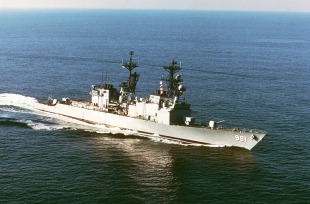Эсминец USS John Hancock (DD-981)
Основная информация
Главные размерения
Машина
- 4 * General Electric LM2500 gas turbines
- 2 * shafts, 80,000 shp (60 MW)
Персонал
Боевые силы и средства
- AN/SPS-40 air search radar
- AN/SPG-60 fire control radar
- AN/SPS-55 surface search radar
- AN/SPQ-9 gun fire control radar
- Mark 23 TAS automatic detection and tracking radar
- AN/SPS-65 Missile fire control radar
- AN/SQS-53 bow mounted Active sonar
- AN/SQR-19 TACTAS towed array Passive sonar
- Naval Tactical Data System
- AN/SLQ-32 Electronic Warfare System
- AN/SLQ-25 Nixie Torpedo Countermeasures
- Mark 36 SRBOC Decoy Launching System
- AN/SLQ-49 Inflatable Decoys
- 2 * 5 in (127 mm) 54 calibre Mark 45 dual purpose guns
- 2 * 20 mm Phalanx CIWS Mark 15 guns
- 1 * 8 cell ASROC launcher (removed)
- 1 * 8 cell NATO Sea Sparrow Mark 29 missile launcher
- 2 * quadruple Harpoon missile canisters
- 2 * Mark 32 triple 12.75 in (324 mm) torpedo tubes (Mk 46 torpedoes)
- 1 * 61 cell Mk 41 VLS launcher for Tomahawk missiles
- 2 * Sikorsky SH-60 Seahawk LAMPS III helicopters
The USS John Hancock (DD-981), a Spruance-class destroyer, marked the sixth vessel of the United States Navy to honor Founding Father John Hancock (1737–1793), renowned as the President of the Continental Congress and the foremost signatory of the Declaration of Independence.
Construction for John Hancock commenced on 16 January 1976 at Ingalls Shipbuilding in Pascagoula, Miss.; it was launched on 29 October 1977 and commissioned on 10 March 1979. Initially stationed at Charleston, South Carolina, the vessel later relocated to Naval Station Mayport, Florida, beginning in 1987.
Following its commissioning, John Hancock embarked on a 'shakedown' cruise at Naval Station Guantanamo Bay, Cuba, initiating regular deployment routines.
In March 1983, John Hancock underwent a six-month overhaul at Ingalls Shipbuilding, Mississippi. Subsequently, the vessel spent three months in Cuba, where it successfully completed GITMO re-certification at Naval Station Guantanamo Bay before being deployed to support operations in the Persian Gulf from October 1984 to April 1985. During this period, Hurricane Diana necessitated an emergency sortie for John Hancock and several other ships at Charleston, South Carolina, in September 1984. While conducting a 'show the flag' patrol in the Persian Gulf during the Tanker War between Iraq and Iran, John Hancock encountered hostile fire from an Iraqi Mirage fighter aircraft, narrowly evading an Exocet missile fired at the destroyer. Regrettably, the missile caused severe damage to a salvage tug that was directly in its path.
In April 1988, John Hancock contributed support in the Persian Gulf for Operation Earnest Will during a six-month deployment, nearing the location where USS Stark had been struck by two Exocet missiles launched by an Iraqi Air Force aircraft in 1987.
In 1991, John Hancock joined the USS America Carrier Battle Group for a two-month North Atlantic deployment in support of Operation North Star '91.
During a Red Sea deployment in March 1994, John Hancock rendered aid to an injured Filipino sailor aboard a merchant vessel. Shortly thereafter, while conducting multinational maritime interdiction operations (MIO) to enforce United Nations sanctions against Iraq, John Hancock, Carr, Underwood, and Taylor intercepted the 20,000th ship since sanctions were initiated in August 1990, with a United States Coast Guard boarding team among them.
As part of the U.S. Atlantic Fleet's surface combatant ships' reorganization in July 1995, John Hancock joined Destroyer Squadron 24 (DESRON 24), with homeport shifts occurring through 1998.
To brace for the impending Hurricane Fran in September 1996, John Hancock was among 13 Navy ships sent to sea. In 1996, it participated in the P2 afloat program trials alongside USS Wasp, USS Carl Vinson, USS Anchorage, and USS George Washington.
Departing on 29 April 1997 for a six-month overseas deployment as part of the USS John F. Kennedy carrier battle group (CVBG), John Hancock engaged in several exercises and operations across different areas. It concluded its operations in the Mediterranean Sea and Adriatic Sea in support of Operation Deliberate Guard and Operation Southern Watch.
Partaking in the sixth International Naval Review (INR) in New York City from 3 to 9 July 2000, John Hancock was subsequently decommissioned on 16 October 2000. Sold to International Shipbreaking Limited of Brownsville, Texas in 2006, the vessel was towed to the Port of Brownsville and scrapped on 29 April 2007.
The official crest of John Hancock symbolizes his service to the country as President of the Continental Congress and Chairman of the Marine Committee, utilizing colors like blue and gold that are customary in the U.S. Navy. The shield represents the Marine Committee, supervised by John Hancock, responsible for initial shipbuilding programs and the commissioning of the second ship named John Hancock into the Navy. The scroll, Liberty Bell, and crossed quills honor Hancock's pivotal role in signing the Declaration of Independence and overseeing the Massachusetts Convention that ratified the federal constitution.
- Комментарии
 ru
ru en
en uk
uk




 Военно-Морские Силы США
Военно-Морские Силы США Ingalls Shipbuilding
Ingalls Shipbuilding